Our guide to full truckload shipping explains what FTL is, its benefits, and costs. Learn to compare FTL vs. LTL and optimize your freight logistics.
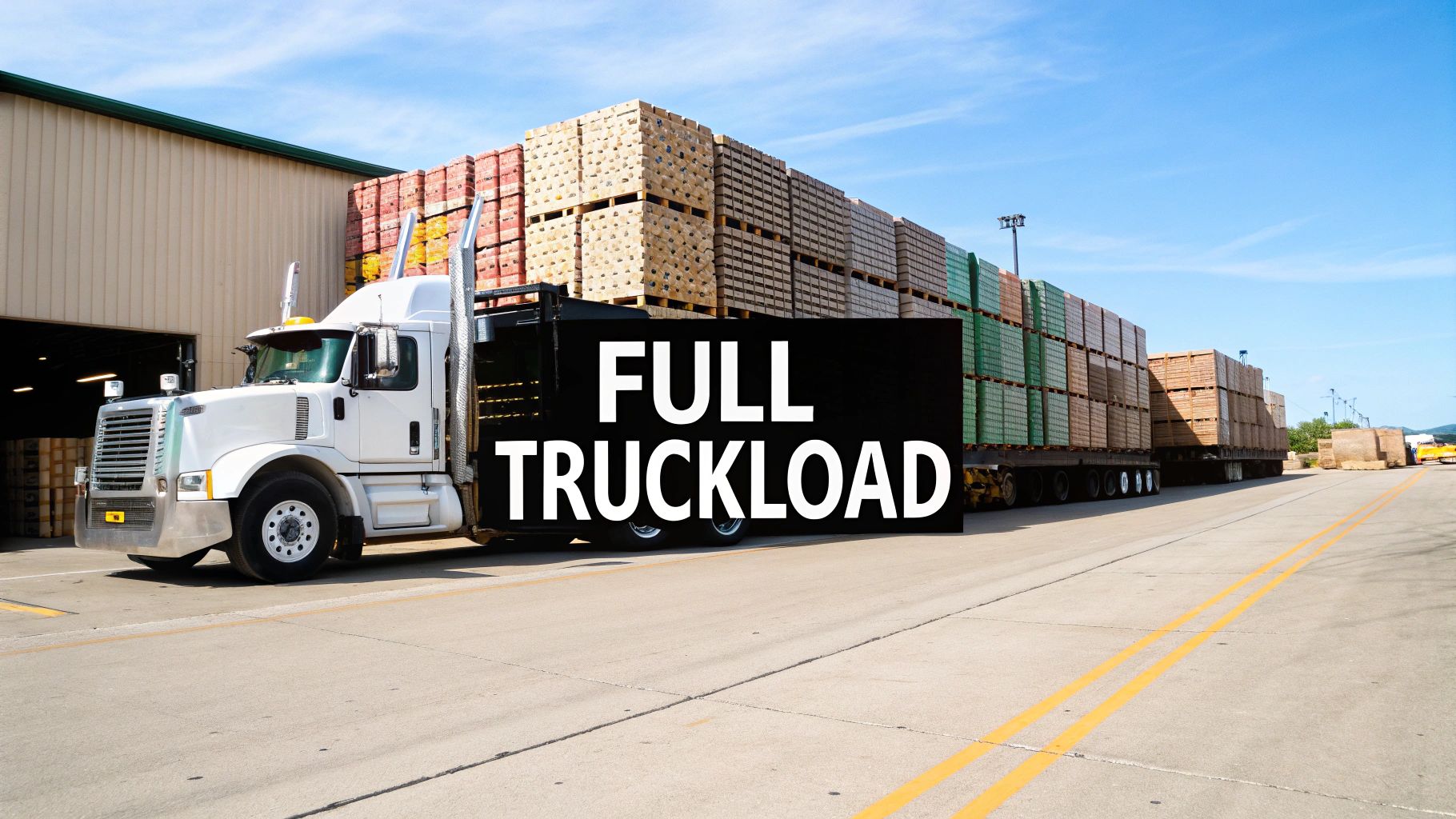
When your freight is big, fragile, or needs to get somewhere fast, full truckload shipping is often the answer. It means your cargo gets its own dedicated truck, traveling directly from your dock to its destination without any detours or extra handling. This straight shot significantly cuts down on transit time and practically eliminates the risk of damage.
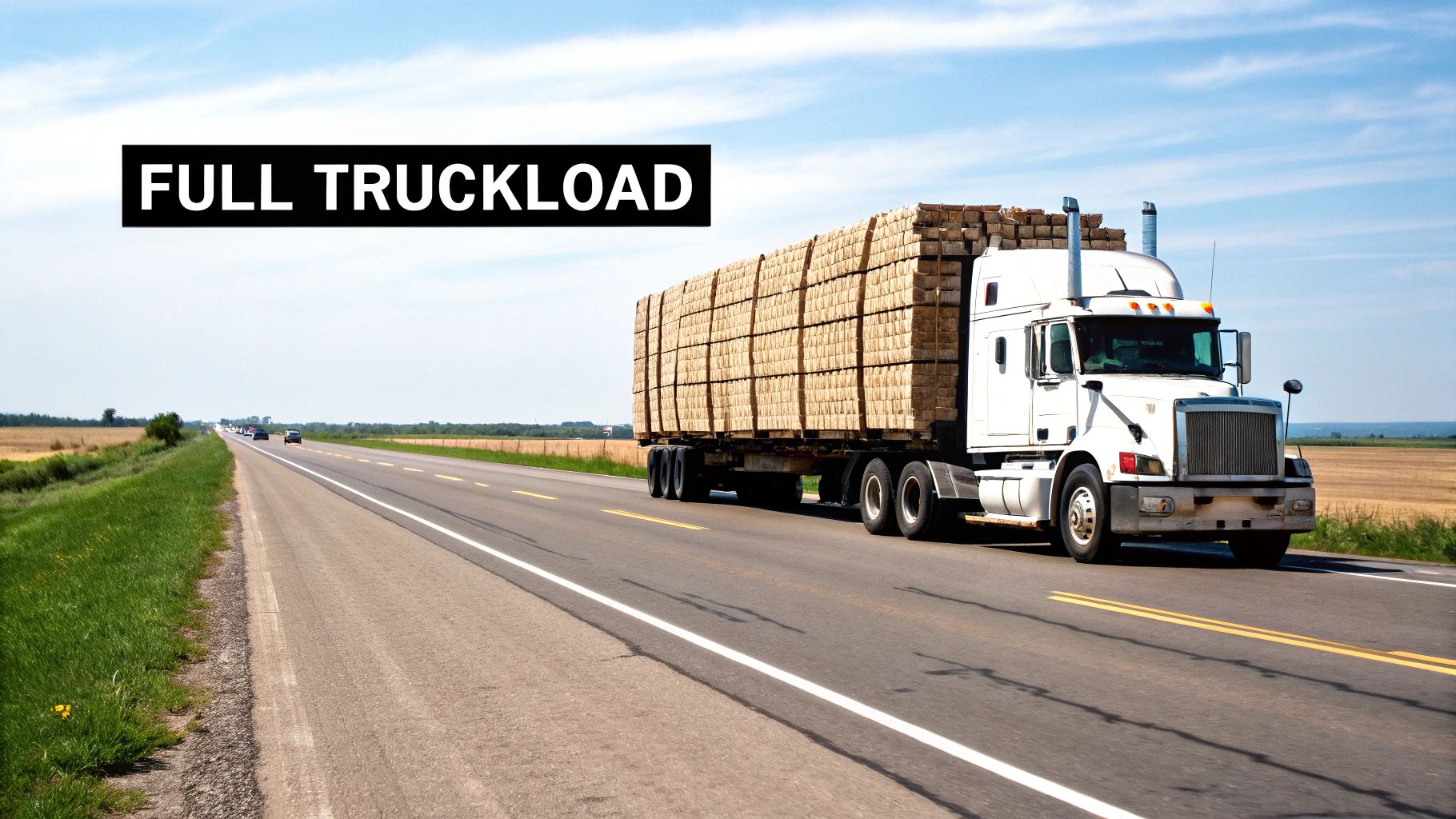
Think of full truckload shipping (FTL) like chartering a private jet for your goods. Instead of sharing space with other shippers, your freight gets the entire truck to itself. That exclusivity is what makes FTL such a powerful tool in logistics.
The journey is as simple as it gets. Once your cargo is loaded and the trailer doors are sealed, that truck is on a direct route to its final stop. No pit stops, no cross-docking, no shuffling your stuff around—just a secure and predictable trip.
You don't always need to have enough freight to pack a 53-foot trailer to the brim. Sometimes, booking a full truck makes perfect sense, even if you leave some empty space.
FTL is probably your best bet if your shipment fits one of these descriptions:
The key advantage is control. With FTL, you control the space, the schedule, and the security of your freight from point A to point B, making it the premier choice for shipments where speed and safety are paramount.
One of the biggest misconceptions about FTL is that the truck has to be, well, full. The reality is that shippers book full truckloads for smaller shipments all the time just to get the dedicated service. For example, a shipment of eight pallets might only take up a third of the trailer, but the peace of mind and speed you get from an exclusive FTL route can be worth every penny.
This flexibility makes FTL a really versatile option. It’s not just for massive shipments; it’s for any shipment that demands a higher level of service. As the industry evolves, shippers are also looking into sustainable transportation solutions to align their freight movements with environmental goals.
Ultimately, choosing FTL is a balancing act—you're weighing the cost against your specific needs for speed, security, and volume.
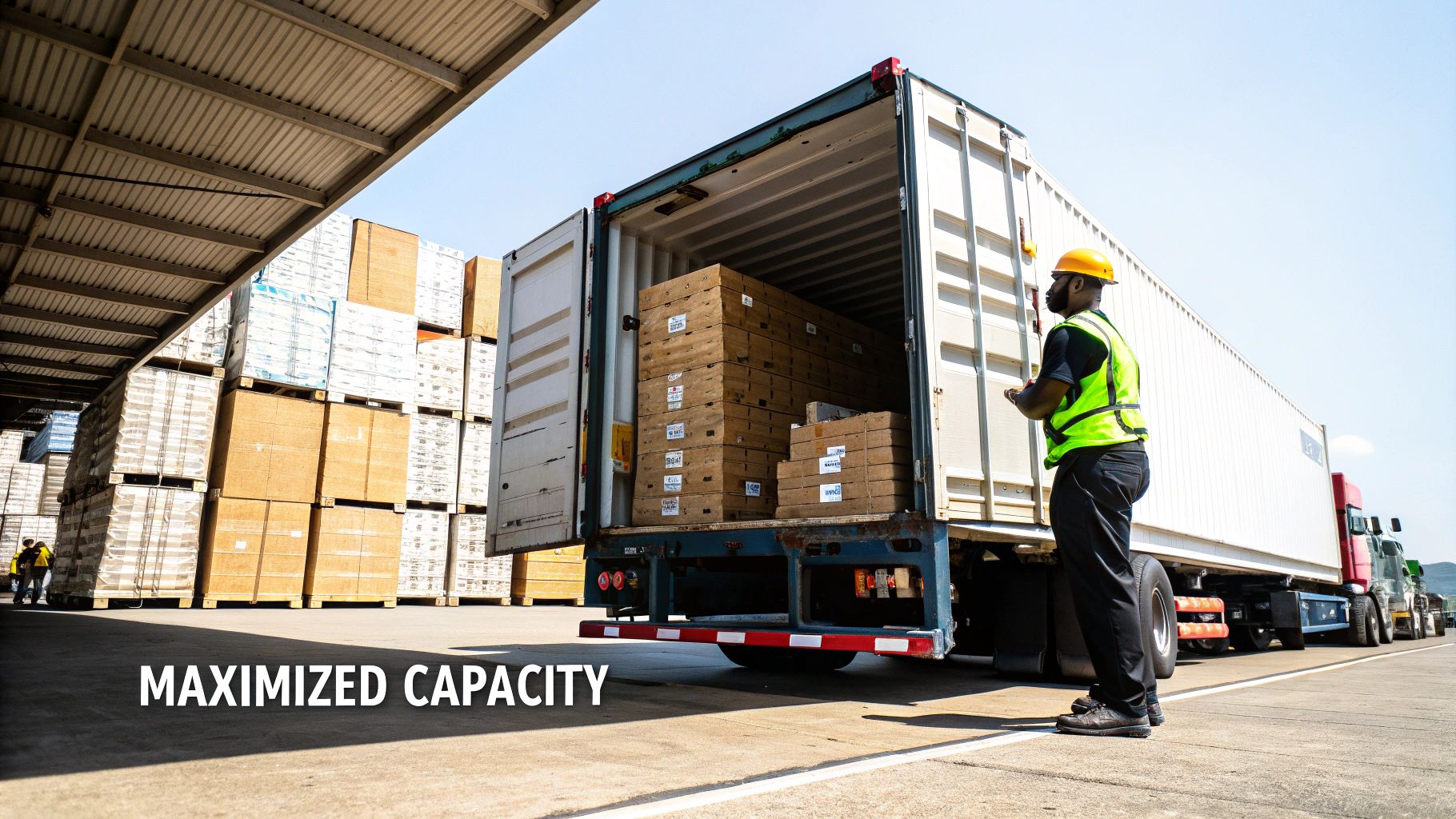
When you book a full truckload shipping service, you’re not just buying space on a truck. You're getting a dedicated solution that delivers efficiency, security, and some serious peace of mind. The real advantages go way beyond just getting your goods from point A to point B.
So, let's dive into the four biggest reasons why experienced shippers lean on FTL.
In logistics, speed is everything. With FTL, your freight gets the VIP treatment. It’s the only cargo on a dedicated truck, which means the driver picks up your load and makes a beeline straight to its destination. No side trips, no other pickups, no extra drop-offs to slow things down.
This direct route means your stuff gets there way faster than with other shipping methods. If you're dealing with time-sensitive inventory, like seasonal products or critical parts for a production line, FTL is hands-down the most reliable way to hit a tight deadline.
One of the biggest headaches in shipping is damage from being handled too much. Every time freight gets moved from one truck to another at a terminal, the risk of it getting dropped, dinged, or lost goes up. It's a simple numbers game.
Full truckload shipping basically solves this problem. Your cargo is loaded once at the start and isn't touched again until it reaches the end of its journey.
Because the trailer is sealed right after loading and stays that way until delivery, FTL gives your shipment a secure, "no-touch" ride. This drastically cuts down the risk of damage, making it the perfect choice for fragile or high-value goods.
This one might seem a bit backward at first, but booking an entire truck can actually be a smart money move, especially when you're shipping a lot of stuff. There's a tipping point where paying for space pallet-by-pallet in an LTL shipment becomes way more expensive than just reserving the whole truck for yourself.
We usually see this happen with shipments of six or more pallets. Once you hit that volume, the cost per unit often plummets with FTL. You get a much better value by paying a single, predictable rate for the entire truck instead of a complicated rate based on weight, class, and the space you use.
With a dedicated truck, your freight is the only thing on board. It’s completely isolated, giving you a level of security that shared shipping just can't touch.
Here's why that matters so much:
This mode's reliability is a big reason for its growth. In fact, the global full truckload road freight transport market was valued at around USD 1.5 trillion and is expected to keep growing, largely because it offers such precision. You can explore more data on the FTL market’s importance on Custom Market Insights.
At the end of the day, choosing full truckload shipping is about taking control. You get your freight there faster, reduce your risks, and often save a good chunk of change on bigger loads. It’s a powerful tool for any business.
Trying to decide between full truckload (FTL) and less-than-truckload (LTL) shipping can feel a lot like choosing between a private taxi and a shared shuttle bus. Both get you where you need to go, but the journey—along with the cost and speed—is completely different. Getting a handle on these differences is the secret to making the smartest, most budget-friendly choice for your freight.
Think of FTL as your own private, non-stop ride. Your freight is the only thing on the truck, and it goes directly from point A to point B. No detours.
On the other hand, LTL is the shared-ride option. Your cargo shares trailer space with freight from several other shippers. This means the truck will be making multiple stops for pickups and deliveries along the way, much like a shuttle bus route.
Not sure which one fits your shipment? Let's break it down.
To make this crystal clear, here’s a straightforward comparison of the two. The right choice really hinges on your specific shipment's size, how quickly you need it there, and what you're actually shipping.
As you can see, there's a clear trade-off. FTL gives you speed and security for a higher price, while LTL offers big cost savings if your shipment is smaller and you have some flexibility on timing.
Some situations just scream full truckload, even if your goods won't fill the whole trailer.
Imagine you're shipping 12 pallets of fragile, high-value electronics. The thought of them being loaded and unloaded multiple times at different terminals in an LTL network is a recipe for disaster. The risk of damage is just too high.
By booking an FTL carrier, you know those electronics get loaded once, the trailer is sealed, and nobody touches them again until they arrive safe and sound. Plus, the faster, more predictable transit time helps you nail those tight retail deadlines.
Now, picture a different scenario. You need to ship two pallets of durable machine parts. They're built tough, they aren't on a rush-hour deadline, and they don't take up much space.
In this case, paying for a whole truck would be a waste of money. LTL is the perfect fit. You only pay for the room your two pallets take up, splitting the transportation costs with other shippers. Yes, it'll take a bit longer and the delivery window won't be as exact, but the cost savings make it the obvious choice. For any business shipping smaller quantities, understanding what LTL stands for in shipping is fundamental to keeping logistics costs in check.
This infographic breaks down some of the key factors that drive full truckload shipping costs.
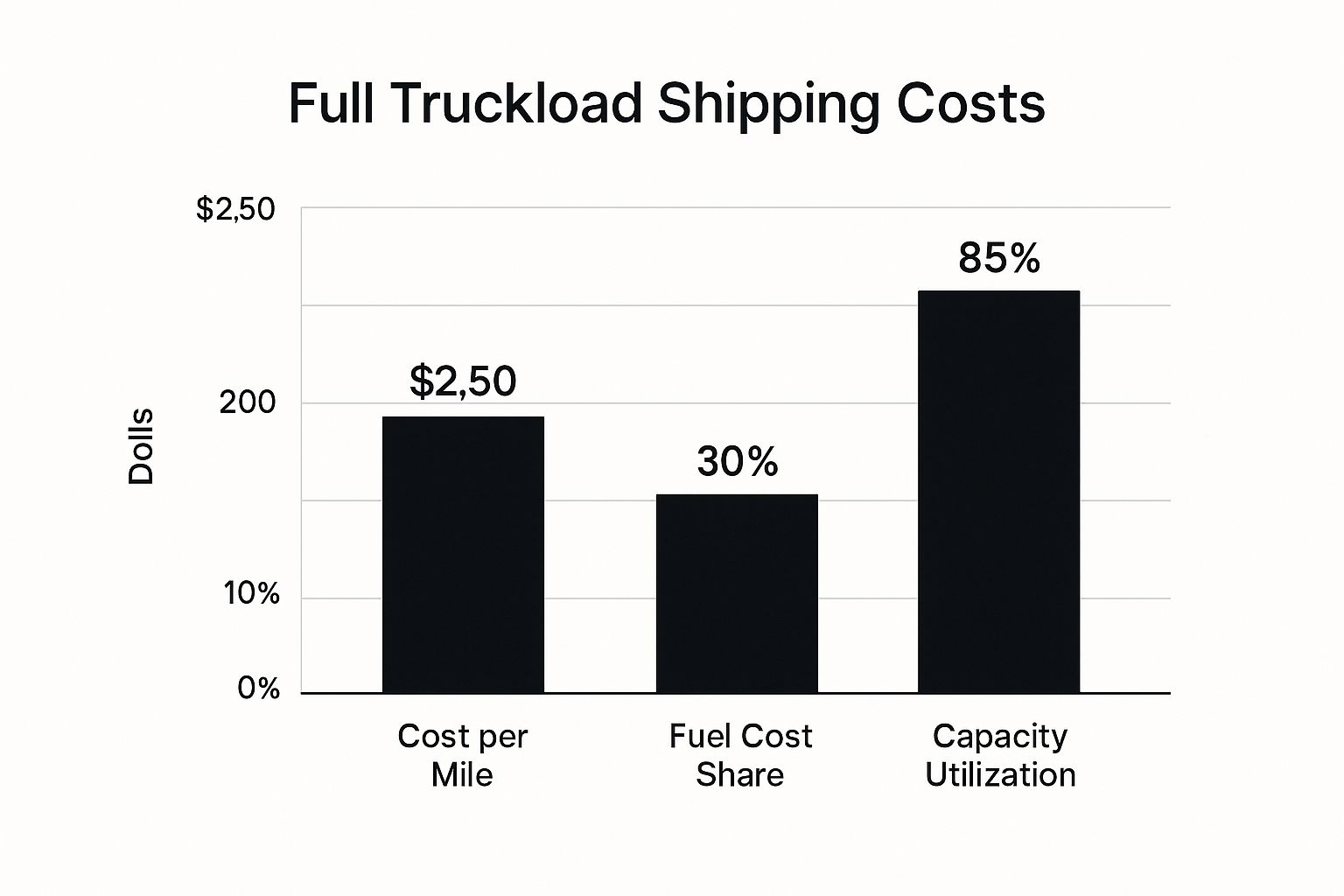
It shows how things like per-mile rates, fuel surcharges, and how full the truck is all add up to the final price you pay.
The decision between FTL and LTL boils down to a simple question of priorities. Are you prioritizing cost savings for a smaller, flexible shipment (LTL)? Or are you prioritizing speed, security, and predictability for a larger or more sensitive one (FTL)?
At the end of the day, knowing when to use each service lets you build a smarter supply chain, keep your products safe, and control your shipping budget like a pro. Every shipment is unique, and having both FTL and LTL in your playbook gives you the flexibility to handle anything.
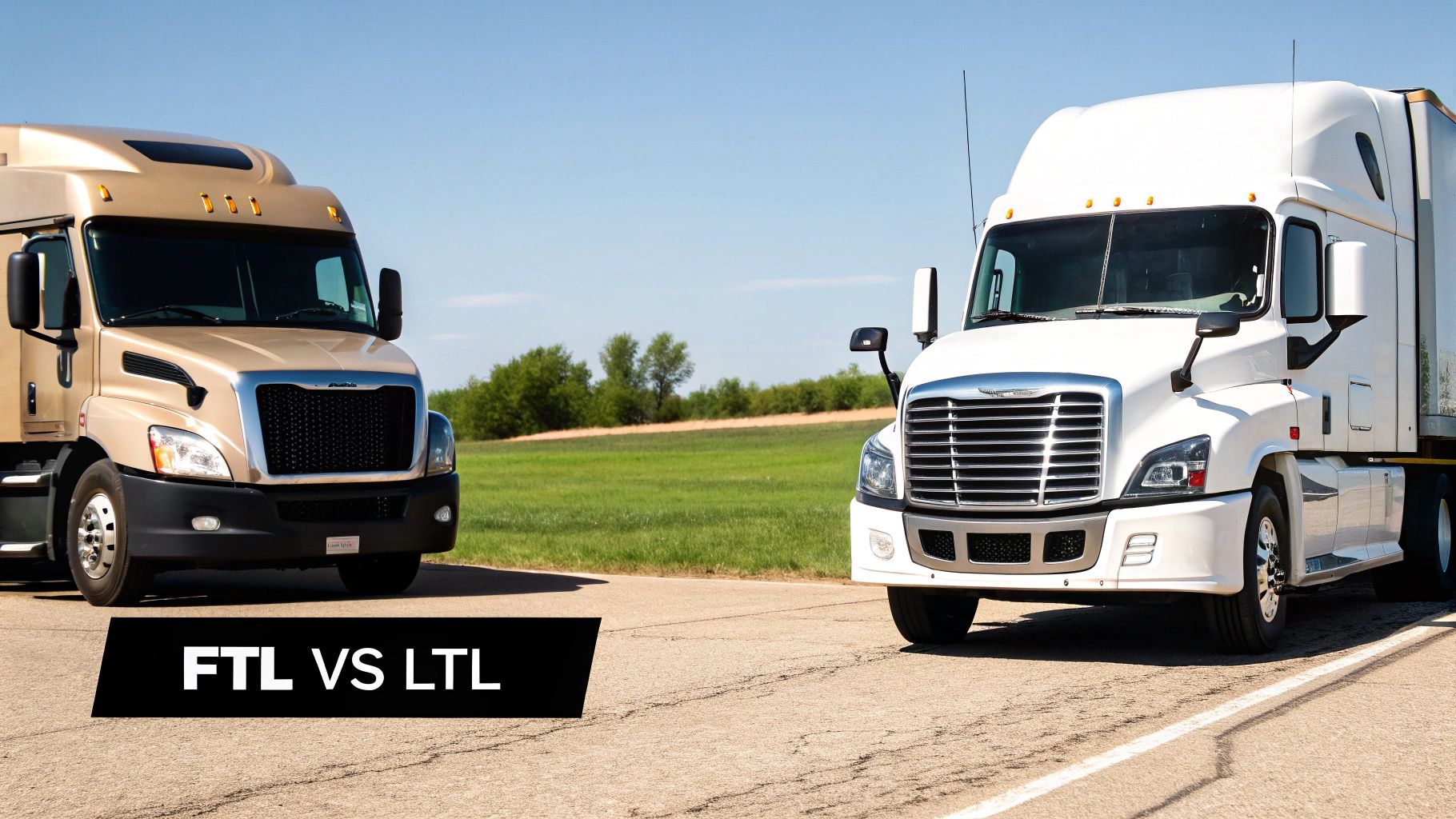
When you get a quote for full truckload shipping, you’re seeing much more than just the cost of driving from A to B. Pulling back the curtain reveals a dynamic pricing system that reacts to the market in real time. Unlike the sticker price on a shelf, FTL rates are always on the move.
Think of it like building with LEGOs—your final cost is made up of a few key pieces. The biggest piece is always the base rate, but other critical parts like fuel surcharges and extra service fees (called accessorials) are needed to complete the picture. Understanding these components helps you budget better and spot chances to save some cash.
Your final shipping bill is never just one flat number. It's actually a combination of distinct charges, with each one covering a different part of the journey. Once you know what they are, any quote you get will make a lot more sense.
Let’s break down the three main pillars of FTL pricing:
Beyond the basic cost breakdown, the wider market plays a huge role in what you end up paying. Just like any other industry, full truckload shipping runs on the simple principles of supply and demand.
The price you're quoted for a specific lane today might be completely different next week. This is because rates are a direct reflection of truck availability, driver capacity, and regional demand at that exact moment in time.
Several factors keep the market in constant motion:
While you can’t control the market, you have more power over your shipping costs than you might think. Simply by being a shipper that’s easy to work with, you can attract better rates and sidestep annoying fees. If you want to dive deeper into the formulas, you can check out our guide on how to calculate freight rates.
Here are a few practical strategies to put into action:
Understanding these moving parts transforms you from a price-taker to a savvy logistics partner.
Booking your first full truckload shipping order might feel a little intimidating, but it’s actually a pretty logical process once you see it broken down. Think of it like a simple playbook with a few key moves. Following these steps will help you cover all your bases, sidestep common pitfalls, and make sure your freight has a smooth ride from start to finish.
Honestly, the whole thing comes down to good preparation and clear communication.
Getting your details straight from the get-go and knowing what to do when the truck pulls up to the destination—that's what makes all the difference. Let’s walk through it, and you’ll be managing FTL shipments like a pro in no time.
Before you can even think about getting a price, you have to know exactly what you're shipping. Carriers and brokers need the nitty-gritty details to give you an accurate quote and send the right truck. If you rush this part, you're just asking for surprise fees and frustrating delays later on.
First things first, pull together this essential info:
Okay, you've got your details. Now it's time to find a truck. You could start calling carriers directly, but that can eat up a lot of your day. A much faster approach is to work with a freight broker or use an online quoting platform. They can shop your load around to multiple carriers at once. Understanding what a freight broker is can help you figure out if that’s the right path for your business.
When the quotes start rolling in, don't just jump at the lowest number. A cheap price isn't always a good deal. Take a moment to look at the carrier’s reputation, their estimated transit times, and what's actually included in the rate.
Once you've picked your carrier and booked the shipment, it's time to get your freight ready for its journey. This means making sure everything is packaged correctly, stacked securely on pallets, and ready to handle the bumps of the road. One of the biggest reasons for damage claims is freight that wasn't prepared properly.
You'll also need to get your Bill of Lading (BOL) filled out.
The Bill of Lading is the most important document in the entire process. It’s your receipt, your contract with the carrier, and proof of ownership all rolled into one. Double-check that every single detail on it is 100% accurate.
On pickup day, make sure your loading area is clear and your team is ready to go. The driver will check the freight against the BOL before sealing the trailer doors. Once they hit the road, you can usually track the truck’s progress.
When the truck arrives at its destination, the receiver's role is just as important. They need to:
This final check is all about accountability and protecting your company. Keep in mind that market conditions can play a big role in finding a truck. When import activity is high, capacity gets tight. For example, recent reports showed U.S. ports handling around 2.24 million twenty-foot equivalent units in a single month. That kind of surge puts a huge demand on inland full truckload services. You can learn more about freight market trends on Arrive Logistics.
Even after covering all the bases, a few questions always seem to pop up when you're getting ready to ship a full truckload. That's completely normal—shipping is full of details, and it pays to get them right.
We've put together some quick, straightforward answers to the questions we hear most often. Think of this as your go-to cheat sheet for handling those final details.
This is a big one. Overloading a truck isn’t just a bad idea; it's illegal and flat-out dangerous. For a standard tractor-trailer, the legal gross vehicle weight (GVW) limit in the U.S. is 80,000 pounds.
But here’s the catch: that 80,000 pounds includes everything—the truck, the trailer, the fuel, and the driver. A typical tractor and an empty 53-foot dry van weigh around 35,000 pounds on their own.
After you subtract the weight of the truck and trailer, you’re left with a maximum cargo weight of about 45,000 pounds. Push past that, and you’re risking hefty fines, major delays, and the nightmare of having to rework the load at a weigh station.
As a rule of thumb, always aim to be slightly under this limit. Accurate weights on your paperwork are your best friend here.
Getting a great rate isn't just about finding the lowest number—it's about being the kind of shipper that carriers want to work with. A little bit of smart planning can make a huge difference in your final cost.
Here are a few proven tips that work time and time again:
The Bill of Lading (BOL) is, without a doubt, the single most important document in your shipment. It's a legally binding document that wears three different hats, acting as the official story of your freight from origin to destination.
Think of it as the shipment's birth certificate, passport, and receipt all rolled into one.
Here’s what it does:
Getting the details on the BOL right is non-negotiable. One small error—like a wrong address or an incorrect pallet count—can lead to big headaches, delays, and unexpected charges.
For a standard full truckload, the short answer is yes, you almost certainly do. A 53-foot dry van is built to be loaded and unloaded from a dock. The trailer floor is about four feet off the ground, which lines up with a standard dock height so a forklift or pallet jack can drive right in.
What if you don't have one? It complicates things, but it’s not always a dealbreaker. You'll just need to plan for some specialized equipment, which usually costs extra.
Here are a few potential workarounds:
The most important thing is to be upfront about your facility when you book the truck. Letting the carrier know you don't have a dock from the start ensures they send the right equipment and saves everyone from a very expensive and frustrating delay.